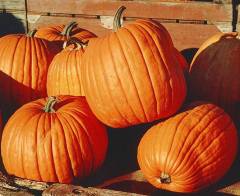Produce is a generalized term for a group of farm-produced goods and, not limited to fruits and vegetables, but also incude grains, cereals, herbs and spices. More specifically, the term "produce" often implies that the products are fresh and generally in the same state as where they were harvested.
Fruits and vegetables are naturally nutrient-rich. That means they are packed with vitamins, minerals and disease-fighting phytonutrients and are still low in calories. According to the healthy eating pyramid, a nutrition guide developed by the Harvard School of Public Health, produce should comprise the bulk of our daily diet for optimal health and nutrition.
Choose from 48 quick and easy CHOW Tips that will help you fit more fresh produce into your diet.
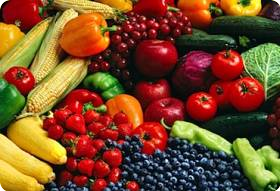
Vegetables
- Menu
-
Vegetables are considered to be edible plants or part(s) of a plant other than a sweet fruit or seed. This typically means the leaf, stem, or root of a plant.
However, the word is not scientific, and its meaning is largely based on culinary and cultural tradition. Therefore, the application of the word is somewhat arbitrary and subjective. For example, some people consider mushrooms to be vegetables even though they are not plants, while others consider them a separate food category.
From a health standpoint, vegetables are a five-star food group: naturally nutrient rich; better tasting than a vitamin pill; low in calories and fat; cholesterol-free and packed with disease-fighting phytonutrients. To maximize your health with vegetables, nutrition experts suggest at least 3 to 5 servings per day—in a rainbow of colors.
Some vegetables can be consumed raw, some may be eaten cooked, and some must be cooked in order to be edible. Vegetables are most often cooked in savory or salty dishes. However, a few vegetables are often used in desserts and other sweet dishes, such as rhubarb pie and carrot cake.
There are at least four definitions relating to fruits and vegetables:
- Fruit (scientific): the ovary of a seed-bearing plant,
- Fruit (culinary): any edible part of a plant with a sweet flavor,
- Vegetable: any edible part of a plant with a savory flavor.
- Vegetable (legal): commodities that are taxed as vegetables in a particular jurisdiction
In everyday grocery-store culinary language, the words "fruit" and "vegetable" are mutually exclusive; plant products that are called fruit are hardly ever classified as vegetables, and vice versa.
Many items commonly called "vegetables—such as eggplants, bell peppers, and tomatoes—are technically fruits, while cereals are both a fruit and a vegetable, as well as some spices like black pepper and chillies. Some plant products, such as corn or peas, may be considered vegetables only while still unripe.
The question of whether the tomato is a fruit or a vegetable found its way into the United States Supreme Court in 1893. The court ruled unanimously in Nix v. Hedden that a tomato is correctly identified as, and thus taxed as, a vegetable, for the purposes of the 1883 Tariff Act on imported produce. The court did acknowledge, however, that, botanically speaking, a tomato is a fruit.
Parts of Plants Used as Culinary Vegetables:
The list of food items called "vegetable" is quite long, and includes many different parts of plants:
-
Flower bud: broccoli, cauliflower, globe artichokes
-
Seeds: sweetcorn (maize), peas, beans, corn
-
Leaves: kale, collard greens, spinach, arugula, beet greens, Chinese cabbage (bok choy), chard, choy sum, turnip greens, endive, lettuce, mustard greens, watercress, garlic chives, Chinese broccoli (gai lan, kai-lan)
-
Leaf sheaths: leeks
-
Buds: Brussels sprouts, capers
-
Stem: Kohlrabi
-
Stems of leaves: celery, rhubarb, cardoon, Chinese celery ("celery"), and lemon grass
-
Stem shoots: asparagus, bamboo shoots, galangal, ginger
-
Tubers: potatoes, Jerusalem artichokes, sweet potatoes, taro, yams
-
Whole-plant sprouts: soybean (moyashi), mung beans, urad, alfalfa
-
Roots: carrots, parsnips, beets, radishes, rutabagas, turnips, burdocks
-
Fruits used as vegetables: tomatillos, christophene, okra, breadfruit, avocado
-
Legumes: green beans, tomatoes, cucumbers, squash, zucchinis, pumpkins, peppers, eggplant, lentils, snow peas, soybean
 The green color of leafy vegetables is due to the presence of the green pigment chlorophyll. Chlorophyll is affected by pH and changes to olive green in acid conditions, and bright green in alkaline conditions. Some of the acids are released in steam during cooking, particularly if cooked without a cover.
The green color of leafy vegetables is due to the presence of the green pigment chlorophyll. Chlorophyll is affected by pH and changes to olive green in acid conditions, and bright green in alkaline conditions. Some of the acids are released in steam during cooking, particularly if cooked without a cover.
The yellow/orange colors of fruits and vegetables are due to the presence of carotenoids, which are also affected by normal cooking processes or changes in pH.
The red/blue coloring of some fruits and vegetables (e.g. blackberries and red cabbage) are due to anthocyanins, which are sensitive to changes in pH. When pH is neutral, the pigments are purple, when acidic, red, and when alkaline, blue. These pigments are very water soluble.
Seasonal Foods:
Seasonality of food refers to the times of year when a given type food is at its peak, either in terms of harvest or its flavor. This is usually the time when the item is the cheapest and the freshest on the market. The food's peak time in terms of harvest usually coincides with when its flavor is at its best. There are some exceptions; an example being sweet potatoes which are best eaten quite a while after harvest.
Seasonal food was practiced since ancient civilizations as people ate what nature produced which varied according to seasons.
|
|
Grains
Grains are small, hard, dry seeds (with or without hull or fruit layers attached) harvested for human food or animal feed. Also, the plants producing such seeds are called grains or grain crops.
Harvested, dry grain has advantages over other staple foods such as the starchy fruits (e.g., plantain, breadfruit) and roots/tubers (e.g., sweet potato, cassava, yam) in being easy to store, handle and transport. In particular, these qualities have allowed mechanical harvesting, shipping of grain by rail or surface, long-term storage in grain silos, large-scale milling or pressing and industrial agriculture in general. Thus, major commodity exchanges deal with soybean, rice, wheat, maize, canola and other grains but not in vegetables, tubers or many other crops.
Classification of Grains
Cereal Grains:
Cereal grains are grasses cultivated for the edible components of their fruit seeds: the endosperm, germ, and bran. Cereal grains are grown in greater quantities and provide more food energy worldwide than any other type of crop; they are therefore staple crops. In their natural form (as in whole grain), they are a rich source of vitamins, minerals, carbohydrates, fats, oils, and protein. However, when refined by the removal of the bran and germ, the remaining endosperm is mostly carbohydrate and lacks the majority of the other nutrients.
- Warm-season cereals: maize (or corn), sorghum, fonio, pearl millet, proso millet, finger millet, foxtail millet, Japanese millet, kodo millet, Job's tears
- Cool-season cereals: wheat, rice, rye, barley, oat, triticale, wild rice, teff
Pseudocereal grains:
Pseudocereal grains, or pseudograins, are the starchy grains produced by broadleaf plants that are used like the true cereals. They are not members of the grass family. Pseudograins look like grain, and in many ways you can cook with them as you would with grains. They are also completely gluten-free. This makes them ideal for the gluten-free diet if you have a gluten allergy or Celiac disease.
Pseudograins consist of the following: amaranth, quinoa, buckwheat.
Grain legumes or Pulses:
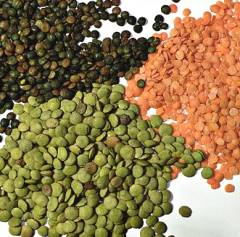 The term "pulse", as used by the Food and Agricultural Organization (FAO), is reserved for crops harvested solely for the dry seed. This excludes green beans and green peas, which are considered vegetable crops. Also excluded are crops that are mainly grown for oil extraction (oilseeds like soybeans and peanuts), and crops which are used exclusively for sowing (clovers, alfalfa). Pulses are important food crops due to their high protein and essential amino acid content; pulses have higher protein than most other plant foods. They may also contain starch or oil.
The term "pulse", as used by the Food and Agricultural Organization (FAO), is reserved for crops harvested solely for the dry seed. This excludes green beans and green peas, which are considered vegetable crops. Also excluded are crops that are mainly grown for oil extraction (oilseeds like soybeans and peanuts), and crops which are used exclusively for sowing (clovers, alfalfa). Pulses are important food crops due to their high protein and essential amino acid content; pulses have higher protein than most other plant foods. They may also contain starch or oil.
Most widely grown: soybean, common bean, chickpea, lima bean, runner bean, pigeon pea, lentil, garden pea, kidney bean, pinto bean, Azuki bean, mung bean, garbanzo, black-eyed pea, pigeon pea,
Oilseeds:
Grains grown primarily for the extraction of their edible oil. Vegetable oils provide dietary energy and some essential fatty acids. They are composed of triglycerides, and also typically contain free fatty acids, monoglycerides and diglycerides, and unsaponifiable lipids.
Most widely grown: rapeseed (including canola), India mustard, black mustard, sunflower seed, safflower, flax seed, hemp seed, poppyseed.
Whole Grains:
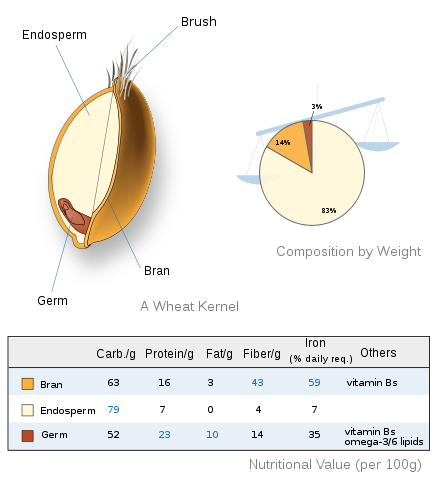 Whole grains are a rich source of vitamins, minerals, carbohydrates, fats, oils, and protein. With whole grains, you get layers of rich nutrients. Whole grains include the bran (outside layer), endosperm (inside layer) and germ (center). However, when refined by the removal of the bran and germ, the remaining endosperm is mostly carbohydrate and lacks the majority of the other nutrients. Wholegrains can generally be sprouted while refined grains generally will not sprout.
Whole grains are a rich source of vitamins, minerals, carbohydrates, fats, oils, and protein. With whole grains, you get layers of rich nutrients. Whole grains include the bran (outside layer), endosperm (inside layer) and germ (center). However, when refined by the removal of the bran and germ, the remaining endosperm is mostly carbohydrate and lacks the majority of the other nutrients. Wholegrains can generally be sprouted while refined grains generally will not sprout.
The consumption of unrefined whole grains has been known to lower blood-cholesterol levels, enhance digestion, and help prevent cancer. Unsurprisingly then, nutrition experts suggest 5 to 10 servings of grains each day.
Common whole grains: Wheat, Oat, Barley (hulled and dehulled, not pearl), Maize, Brown rice, Farro, Emmer, Einkorn, Rye, Spelt, Millet, Quinoa, Amaranth, Triticale, Teff, Sprouted Grains, and Buckwheat.
Identifying Wholegrain Products:
Wholegrain products can be identified by the ingredients list. Typically, if the ingredient lists "wholewheat," "wholemeal," or "whole corn" as the first ingredient, the product is a wholegrain food item. On the other hand, terms such as "enriched" and "bromated," among others, could indicate that the food lacks wholegrain.
Wholemeal products are made by grinding whole grains in order to make wholegrain flour. "Wheat flour" (as opposed to "wholegrain wheat flour" or "wholewheat flour") as the first ingredient is not a clear indicator of the product's wholegrain content. If two ingredients are listed as grain products but only the second is listed as wholegrain, the entire product may contain between 1% and 49% whole grain. Many breads are colored brown (often with molasses or caramel color) and made to look like wholegrain, but are not. In addition, some food manufacturers make foods with whole-grain ingredients, but, because whole-grain ingredients are not the dominant ingredient, they are not wholegrain products.
Common whole grain products: Whole wheat flour, Whole wheat Bread, Whole wheat Pasta, Rolled oats or oat groats, Triticale flour, Popcorn, and Teff flour.
Common refined-grain products: White rice, White flour, White bread, Hominy, and Pasta (non-whole wheat varieties).
Proper Food Safety
For food safety, the CDC recommends proper vegetable handling and preparation to reduce the risk of food contamination and foodborne illness. Fresh vegetables should be carefully selected. At the store, they should not be damaged or bruised and pre-cut pieces should be refrigerated or surrounded by ice. All vegetables should be rinsed before eating. This recommendation also applies to produce with rinds or skins that are not eaten. It should be done just before preparing or eating to avoid premature spoilage.
Vegetables should be kept separate from raw foods like meat, poultry, and seafood, as well as any cooking utensils or surfaces that may have come into contact with them (e.g. cutting boards). Vegetables, if they are not going to be cooked, should be thrown away if they have touched raw meat, poultry, seafood or eggs. All cut, peeled, or cooked fruits and vegetables should be refrigerated within 2 hours. After a certain time, harmful bacteria may grow on them and increase the risk of foodborne illness.
Proper Food Storage
Proper post harvest storage aimed at extending and ensuring shelf life is best effected by efficient cold chain application. All vegetables benefit from proper post harvest care.
Many root and non-root vegetables that grow underground can be stored through winter in a root cellar or other similarly cool, dark and dry place to prevent mold, greening and sprouting. Care should be taken in understanding the properties and vulnerabilities of the particular roots to be stored. These vegetables can last through to early spring and be nearly as nutritious as when fresh.
During storage, leafy vegetables lose moisture, and the vitamin C in them degrades rapidly. They should be stored for as short a time as possible in a cool place, in a container or plastic bag.
Health Benefits of Vegetables & Grains
The nutritional content of vegetables varies considerably, though generally they contain little protein or fat, and varying proportions of vitamins, provitamins, dietary minerals, and carbohydrates.
Vegetables contain a great variety of other phytochemicals, some of which have been claimed to have antioxidant, antibacterial, antifungal, antiviral and anticarcinogenic properties.
Diets containing recommended 3 to 5 servings of vegetables per day—in a rainbow of colors—may help lower the risk of heart diseases and type 2 diabetes. These diets may also protect against some cancers and decrease bone loss. The potassium provided by vegetables may help prevent the formation of kidney stones.
Whole grains and vegetables are good sources of dietary fiber. There are many health benefits of a high-fiber diet. Dietary fiber helps reduce the chance of gastrointestinal problems such as constipation and diarrhea by increasing the weight and size of stool and softening it. Insoluble fiber, found in whole-wheat flour, nuts and vegetables, especially stimulates peristalsis—the rhythmic muscular contractions of the intestines which move digesta along the digestive tract. Soluble fiber, found in oats, peas, and beans dissolves in water in the intestinal tract to produce a gel which slows the movement of food through the intestines. This may help lower blood glucose levels because it can slow the absorption of sugar. Additionally, fiber, perhaps especially that from whole grains, is thought to possibly help lessen insulin spikes, and therefore reduce the risk of type 2 diabetes.
Consumption of whole grains has also been consistently linked with a significant decrease in risk factors for cardiovascular disease. Regular wholegrain consumption lowers LDL and triglyceride levels, which contributes to an overall 26% reduction in coronary heart disease risk factors. In addition, whole grain consumption is inversely related to hypertension, diabetes, and obesity when compared to refined grains, all of which are negative indicators in total cardiovascular health.
Fruits
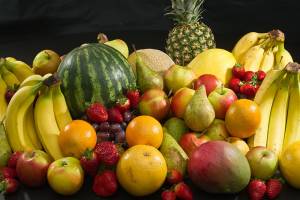 The term "fruit" has different meanings dependent on context. In non-technical usage, such as food preparation, fruit normally means the fleshy seed-associated structures of certain plants that are sweet and edible in the raw state, such as apples, oranges, grapes, strawberries, juniper berries and bananas. Seed-associated structures that do not fit these informal criteria are usually called by other names, such as vegetables, pods, nut, ears and cones.
The term "fruit" has different meanings dependent on context. In non-technical usage, such as food preparation, fruit normally means the fleshy seed-associated structures of certain plants that are sweet and edible in the raw state, such as apples, oranges, grapes, strawberries, juniper berries and bananas. Seed-associated structures that do not fit these informal criteria are usually called by other names, such as vegetables, pods, nut, ears and cones.
Fruits (in either sense of the word) are the means by which many plants disseminate seeds. Most plants bearing edible fruits, in particular, coevolved with animals in a symbiotic relationship as a means for seed dispersal and nutrition, respectively; in fact, many animals (including humans to some extent) have become dependent on fruits as a source of food. Fruits account for a substantial fraction of world's agricultural output.
Many hundreds of fruits, including fleshy fruits like apple, peach, pear, kiwifruit, watermelon and mango are commercially valuable as food, eaten both fresh and as jams, marmalade and other preserves. Fruits are also in manufactured foods like cookies, muffins, yoghurt, ice cream, cakes, and many more. Many fruits are used to make beverages, such as fruit juices (orange juice, apple juice, grape juice, etc.) or alcoholic beverages, such as wine or brandy. Apples are often used to make vinegar. Fruits are also used for gift giving, Fruit Basket and Fruit Bouquet are some common forms of fruit gifts.
Botanical Fruit vs Culinary Fruit:
Many fruits that, in a botanical sense, are true fruits are actually treated as vegetables in cooking and food preparation, because they are not particularly sweet. These culinary vegetables include cucurbits (e.g., squash, pumpkin, and cucumber), tomatoes, peas, beans, corn, eggplant, bell pepper, okra, squash, pumpkin, green bean, cucumber and zucchini.
Olive fruit is pressed for olive oil. In addition, some spices, such as allspice, vanilla, paprika, allspice, black pepper and chilies, are fruits, botanically speaking because they are derived from berries.
In contrast, occasionally a culinary fruit is not a true fruit in the botanical sense. For example, rhubarb is often referred to as a fruit, because it is used to make sweet desserts such as pies, though only the petiole of the rhubarb plant is edible. In the culinary sense of these words, a fruit is usually any sweet-tasting plant product, especially those associated with seed(s), a vegetable is any savory or less sweet plant product, and a nut is any hard, oily, and shelled plant product.
Technically, a cereal grain is also a kind of fruit, a kind which is termed a caryopsis. However, the fruit wall is very thin, and is fused to the seed coat, so almost all of the edible grain is actually a seed. Therefore, cereal grains, such as corn, wheat and rice are better considered as edible seeds, although some references do list them as fruits.
Anatomy of Simple Fruits:
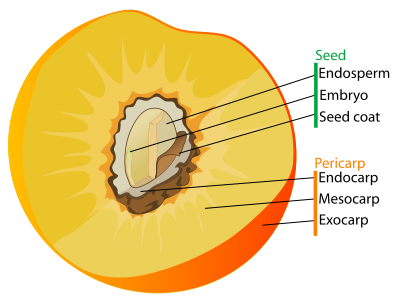 Fruit anatomy is the internal structure of fruit, the mature ovary or ovaries from one or more flowers. In fleshy fruits, the outer and often edible layer is the pericarp, which is the tissue that develops from the ovary wall of the flower and surrounds the seeds. In berries and drupes, the pericarp forms the edible tissue around the seeds.
Fruit anatomy is the internal structure of fruit, the mature ovary or ovaries from one or more flowers. In fleshy fruits, the outer and often edible layer is the pericarp, which is the tissue that develops from the ovary wall of the flower and surrounds the seeds. In berries and drupes, the pericarp forms the edible tissue around the seeds.
The pericarp itself is typically made up of three distinct layers: the exocarp, which is the most-outside layer or peel, the mesocarp, which is the middle layer or pith, and the endocarp, which is the inner layer surrounding the hollowed ovary or the containing seeds.
The exocarp is the outermost layer of the pericarp (or fruit). The exocarp forms the tough outer skin of the fruit, which bears oil glands and pigments.
The mesocarp is the succulent and fleshy middle layer of the pericarp of drupaceous fruit, between the exocarp and the endocarp; it is usually the part of the fruit that is eaten. In a hesperidium such as a citrus fruit, the mesocarp is also referred to as pith because of its soft fiber. It is part of the peel which is commonly removed by hand.
The endocarp is the inside layer of the pericarp (or fruit), which directly surrounds the seeds. It may be membranous as in citrus where it is the only part consumed, or thick and hard as in the stone fruits such as peaches, cherries, plums, and apricots. In nuts, it is the stony layer that surrounds the kernel of pecans, walnuts, etc., and that is removed prior to consumption. In citrus, the endocarp is separated into sections, which are most commonly called segments. The juicy pulp filling the segments is usually referred to as juice vesicles.
Categories of Fruits
Fruits are so diverse that it is difficult to devise a classification scheme that includes all known fruits. Many common terms for seeds and fruit are incorrectly applied, a fact that complicates understanding of the terminology.
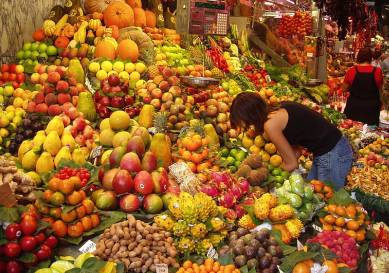 Plant scientists have grouped fleshy fruits into three main groups: simple fruits, aggregate fruits, and composite or multiple fruits.
Plant scientists have grouped fleshy fruits into three main groups: simple fruits, aggregate fruits, and composite or multiple fruits.
- Berry – simple fruit and seeds created from a single ovary
- Pepo – Berries where the skin is hardened, like cucurbits
- Hesperidium – Berries with a rind and a juicy interior, like most citrus fruit
- Compound fruit, which includes:
- Aggregate fruit – with seeds from different ovaries of a single flower
- Multiple fruit – fruits of separate flowers, merged or packed closely together
- Accessory fruit – where some or all of the edible part is not generated by the ovary
|
True Berry |
Pepo |
Hesperidium |
Aggregate Fruit |
Multiple Fruit |
Accessory Fruit |
|---|---|---|---|---|---|
|
Blackcurrant, Redcurrant, Gooseberry, Tomato, Eggplant, Guava, Chili pepper, Pomegranate, Kiwifruit, Grape, Cranberry, Blueberry |
Seedlessness is an important feature of some fruits of commerce. Commercial cultivars of bananas and pineapples are examples of seedless fruits. Some cultivars of citrus fruits (especially navel oranges), satsumas, mandarin oranges, table grapes, grapefruit, and watermelons are valued for their seedlessness. In some species, seedlessness is the result of parthenocarpy, where fruits set without fertilization. Parthenocarpic fruit set may or may not require pollination but most seedless citrus fruits require stimulus from pollination to produce fruit.
Common Edible Fruits by Climate
Temperate Fruits:
Fruits of temperate climates are almost always borne on trees or woody shrubs or lianas. They will not grow adequately in the tropics, as they need a period of cold (a chilling requirement) each year before they will flower. The apple, pear, cherry, and plum are the most widely grown and eaten, owing to their adaptability. Many other fruits are important regionally but do not figure prominently in commerce. Many sorts of small fruit on this list are gathered from the wild.
Mediterranean and Subtropical Fruits:
Fruits in this category are not hardy to extreme cold, as the preceding temperate fruits are, yet tolerate some frost and may have a modest chilling requirement.
Tropical Fruits:
Tropical fruits grow on plants of all habitats. The only characteristic that they share is an intolerance of frost.
|
Temperate Fruits |
Mediterranean and Subtropical Fruits |
Tropical Fruits |
|---|---|---|
|
Apple, Apricot, Blackberry, Blueberry, Boysenberry, Cherry, Cranberry, Currant, Dewberry, Elderberry, Gooseberry, Hackberry, Huckleberry, Nectarine, Peach, Pear, Plum, Raspberry, Red Mulberry, Strawberry, White Mulberry, Wineberry |
Avocado, Black mulberry, Blood Orange, Citron, Clementine, Date, Fig, Grape, Grapefruit, Guava, Jujube, Lemon, Limes, Longan, Lychee, Mandarin, Orange, Passion fruit, Peanut, Pomegranate, Tangerine, Tamarillo
|
Açaí, Ackee, Allspice, Golden Apple, Avocado, Banana, Breadfruit, Cashew, Cinnamon, Clove, Coconut, Chili pepper, Date, Feijoa, Fig, Grapefruit, Guava, Honeydew (melon), Jackfruit, Kiwifruit, Lemon, Lime, Lychee, Macadamia, Mandarin, Mung Bean, Nutmeg, Orange, Olive, Papaya, Passionfruit, Pineapple, Pistachio, Pomegranate, Soursop, Summer squash, Tamarind, Tomato, Vanilla, Watermelon |
Seasonal Foods
Seasonality of food refers to the times of year when a given type food is at its peak, either in terms of harvest or its flavor. This is usually the time when the item is the cheapest and the freshest on the market. The food's peak time in terms of harvest usually coincides with when its flavor is at its best. There are some exceptions; an example being sweet potatoes which are best eaten quite a while after harvest.
Seasonal food was practiced since ancient civilizations as people ate what nature produced which varied according to seasons.
|
|
Proper Food Safety
Food safety is a scientific discipline describing handling, preparation, and storage of food in ways that prevent foodborne illness. This includes a number of routines that should be followed to avoid potentially severe health hazards.
Food can transmit disease from person to person as well as serve as a growth medium for bacteria that can cause food poisoning. The CDC recommends proper fruit handling and preparation to reduce the risk of food contamination and foodborne illness.
-
Fresh fruits should carefully be selected. At the store, they should not be damaged or bruised and pre-cut pieces should be refrigerated or surrounded by ice.
-
All fruits should be rinsed before eating. This recommendation also applies to fruits with rinds or skins that are not eaten. It should be done just before preparing or eating to avoid premature spoilage.
-
Fruits should be kept separate from raw foods like meat, poultry, and seafood, as well as utensils that have come in contact with raw foods.
-
Fruits that are not going to be cooked immediately should be thrown away if they have touched raw meat, poultry, seafood or eggs.
-
All cut, peeled, or cooked fruits should be refrigerated within two hours. After a certain time, harmful bacteria may grow on them and increase the risk of foodborne illness.
Culinary Nuts
A nut is a hard-shelled fruit of some plants having an indehiscent seed. While a wide variety of dried seeds and fruits are called nuts in English, only a certain number of them are considered by biologists to be true nuts. Nuts are an important source of nutrients for both humans and wildlife.
Nuts are a composite of the seed and the fruit, where the fruit does not open to release the seed. Most seeds come from fruits, and the seeds are free of the fruit, unlike nuts such as hazelnuts, hickories, chestnuts and acorns, which have a stony fruit wall and originate from a compound ovary. Culinary usage of the term is less restrictive, and some nuts as defined in food preparation, like pistachios and Brazil nuts, are not nuts in a biological sense. Essentially any large, hard-walled, oily kernel found within a shell and used in food may be regarded as a nut.
Because nuts generally have a high oil content, they are a highly prized food and energy source. A large number of seeds are edible by humans and used in cooking, eaten raw, sprouted, or roasted as a snack food, or pressed for oil that is used in cookery.
Nuts used for food, whether true nut or not, are among the most common food allergens.
Some fruits and seeds that do not meet the botanical definition but are nuts in the culinary sense:
|
|
Health Benefits of Fruits and Nuts
-
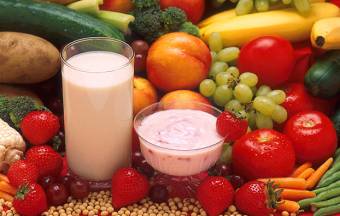 Fruits are generally high in fiber, water, vitamin C and sugars, although this latter varies widely from traces as in lime, to 61% of the fresh weight of the date. Fruits also contain various phytochemicals that do not yet have an RDA/RDI listing under most nutritional factsheets, and which research indicates are required for proper long-term cellular health and disease prevention. Regular consumption of fruit is associated with reduced risks of cancer, cardiovascular disease (especially coronary heart disease), stroke, Alzheimer disease, cataracts, and some of the functional declines associated with aging.
Fruits are generally high in fiber, water, vitamin C and sugars, although this latter varies widely from traces as in lime, to 61% of the fresh weight of the date. Fruits also contain various phytochemicals that do not yet have an RDA/RDI listing under most nutritional factsheets, and which research indicates are required for proper long-term cellular health and disease prevention. Regular consumption of fruit is associated with reduced risks of cancer, cardiovascular disease (especially coronary heart disease), stroke, Alzheimer disease, cataracts, and some of the functional declines associated with aging. -
Fruits (especially plums, prunes, and figs) are good sources of dietary fiber. There are many health benefits of a high-fiber diet. Dietary fiber helps reduce the chance of gastrointestinal problems such as constipation and diarrhea by increasing the weight and size of stool and softening it. Insoluble fiber, found in nuts especially stimulates peristalsis—the rhythmic muscular contractions of the intestines which move digesta along the digestive tract. Soluble fiber, found in many fruits, dissolves in water in the intestinal tract to produce a gel which slows the movement of food through the intestines. This may help lower blood glucose levels because it can slow the absorption of sugar.
-
Phytochemicals are typically found in colorful fruits. One of the principal classes of phytochemicals are polyphenol antioxidants, chemicals that are known to provide certain health benefits to the cardiovascular system and immune system.
-
Fruits contain a great variety of other phytochemicals, some of which have been claimed to have antioxidant, antibacterial, antifungal, antiviral and anticarcinogenic properties
-
Diets that include a sufficient amount of potassium from fruits and vegetables also help reduce the chance of developing kidney stones and may help reduce the effects of bone-loss.
-
Fruits are also low in calories which would help lower one's calorie intake as part of a weight-loss diet.
-
Several epidemiological studies have revealed that people who consume nuts regularly are less likely to suffer from coronary heart disease (CHD). Many clinical trials have found that consumption of various nuts such as almonds and walnuts can lower serum LDL cholesterol concentrations. Although nuts contain various substances thought to possess cardioprotective effects, scientists believe that their Omega 3 fatty acid profile is at least in part responsible for the hypolipidemic response.
-
In addition to possessing cardioprotective effects, nuts generally have a very low glycemic index (GI). Consequently, dietitians frequently recommend nuts be included in diets prescribed for patients with insulin resistance problems such as diabetes mellitus type 2.
-
One study found that people who eat nuts live two to three years longer than those who do not. However, this may be because people who eat nuts tend to eat less junk food.
-
Nuts contain the essential fatty acids linoleic and linolenic acids, and the fats in nuts for the most part are unsaturated fats, including monounsaturated fats.
-
Many nuts are good sources of vitamins E and B2 (riboflavin, an antioxidant), and are rich in protein, folate, fiber, and essential minerals such as magnesium, phosphorus, potassium, copper, and selenium. Raw or unroasted walnuts are considered the healthiest, with twice as many anti-oxidants as other nuts.
-
Nuts are most healthy in their raw form. The reason is that up to 15% of the healthy oils that naturally occur in nuts are lost during the roasting process.
The Dirty Dozen
There's alot of talk about the "dirty dozen" in the media. The "dirty dozen" refers to the top 12 most contaminated fruits and vegetables from a list of 53 conventionally grown fruits and vegetables that retain residual levels of agricultural pesticides despite being adequate washed and, when applicable, peeled. It is important to note that some plants absorbed pesticides systemically, therefore will retain pesticide residue in which case a produce wash would have limited effect.
This list and ranking of the 53 fruits and vegetables was created by the Environmental Working Group (EWG), which analyzed pesticide residue testing data from the US Department of Agriculture and Food and Drug Administration.
If you cannot afford to buy organic, by all means, eat your fruits and vegetables! The health benefits of a diet rich in fruits and vegetables outweigh the risks of pesticide exposure. The list below is to help reduce your exposures as much as possible. Eating conventionally-grown produce is far better than not eating fruits and vegetables at all.
Vegetables:
Most Contaminated Vegetables: #2 Celery, #5 Spinach, #8 Sweet Bell Peppers, #9 Potatoes, #11 Lettuce, #12 Kale/Collard Greens
Mid-Range: #13 Cilantro, #14 Cucumbers, #19 Hot peppers, #20 Green beans, #21 Carrots, #26 Summer squash, #28 Broccoli, #29 Green onions, #33 Cauliflower, #34 Tomatoes, #38 Winter squash, #39 Mushrooms
Least Contaminated Vegetables: #41 Sweet Potatoes, #43 Cabbage, #46 Eggplant, #48 Sweet Peas (Frozen), #49 Asparagus, #50 Avocado, #53 Sweet Corn (Frozen), #53 Onions
Fruits:
Most Contaminated Fruits: #1 Apples, #3 Strawberries, #4 Peaches, #6 Nectarines (imported), #7 Grapes (imported), #10 Blueberries (domestic)
Mid-Range: #15 Grapes (domestic), #16 Cherries, #17 Pears, #18 Nectarines (domestic), # 22 Plums (imported), #23 Blueberries (imported), #24 Raspberries, # 27 Oranges, #30 Bananas, #31 Cantaloupe (imported), #32 Honeydew melon, #35 Papaya, #36 Cranberries. #37 Plums (domestic)
Least Contaminated Fruits: #40 Grapefruit, #42 Watermelon, #44 Kiwi, #45 Cantaloupe (domestic), #47 Mangoes, #51 Pineapples
Pesticides Related Health Risks
The Centers for Disease Control and Prevention’s national biomonitoring program has detected pesticides in blood and urine samples from 96% of more than 5,000 Americans age 6 and older (CDC 2009). The agency reported finding 21 chemical biomarkers corresponding to 28 pesticides that can contaminate fresh fruits and vegetables, according to an EWG analysis of CDC and EPA data. More than 60% of Americans tested positive for seven or more of these pesticides and pesticide metabolites.
Health effects of pesticides may be acute or delayed in those who are exposed. As acknowledged by U.S. and international government agencies, different pesticides have been linked to a variety of health problems, including:
- brain and nervous system toxicity: Parkinson's disease, dementia
- cancer: leukemia, lymphoma, brain, kidney, breast, prostate, pancreas, liver, lung, and skin cancers
- hormone disruption
- skin, eye and lung irritation
Recent studies of neurotoxic organophosphate compounds used on some fruits and vegetables have found that children with high exposures face greater risks for impaired intelligence and neurological problems.
Three epidemiological studies published in Environmental Health Perspectives in April 2011 show a clear link between a mother’s exposure to organophosphate insecticides during pregnancy and deficits to children’s learning and memory that persist through the ages of 6 to 9.
-
Columbia University researchers linked deficits in intelligence quotient (IQ) and working memory among seven-year-olds born in New York City to prenatal exposure to the pesticide chlorpyrifos, an organophosphate popular for residential pest control until EPA banned its use in homes in 2001 (Rauh 2011). Children continue to be exposed to organophosphate pesticides that contaminate common foods (Lu 2008, 2010).
-
Researchers from the Mt. Sinai Medical Center linked prenatal organophosphate exposures among New York City-born children to impaired perceptual reasoning, a measure of nonverbal problem-solving skills (Engel 2011).
-
Scientists at the University of California, Berkeley, found that children born in a Latino farmworker community to women with high organophosphate exposures had children with lower intelligence scores (IQ) at age 7, relative to children born to women with lower pesticide exposures (Bouchard 2011).
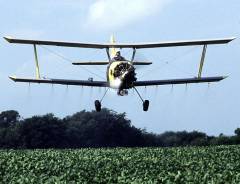 Biomonitoring studies underscore concern for everyday exposures as well. A scientific paper by Devon Payne-Sturges of EPA’s National Center for Environmental Research estimates that 40% of children tested by CDC from 1999 to 2002 had unsafe levels of organophosphate in their bodies (Paynes-Sturges 2009).
Biomonitoring studies underscore concern for everyday exposures as well. A scientific paper by Devon Payne-Sturges of EPA’s National Center for Environmental Research estimates that 40% of children tested by CDC from 1999 to 2002 had unsafe levels of organophosphate in their bodies (Paynes-Sturges 2009).
In May 2010 researchers at Harvard University found increased risk for attention deficit-hyperactive disorder among American children exposed to typical levels of organophosphates.
Studies led by Chensheng Lu of Emory University found that elementary school-age children’s body burdens of organophosphate pesticides, including chlorpyrifos and malathion, peaked during the summer, when they ate the most fresh produce. But just five days after switching to an all-organic diet, their bodies were essentially pesticide-free (Lu 2006, 2008).
The American Medical Association recommends limiting exposure to pesticides and using safer alternatives: "Particular uncertainty exists regarding the long-term effects of low-dose pesticide exposures. Current surveillance systems are inadequate to characterize potential exposure problems related either to pesticide usage or pesticide-related illnesses…Considering these data gaps, it is prudent…to limit pesticide exposures…and to use the least toxic chemical pesticide or non-chemical alternative."
Organic Produce
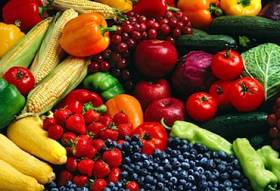 A consumer backlash against food sold for taste, convenience, and profit rather than nutrition and other values (e.g. reduce waste, be natural, be ethical) has led agriculture to also provide organic food, minimally processed foods, and minimally packaged foods to maximally satisfy all segments of society thus generating maximum return on investment.
A consumer backlash against food sold for taste, convenience, and profit rather than nutrition and other values (e.g. reduce waste, be natural, be ethical) has led agriculture to also provide organic food, minimally processed foods, and minimally packaged foods to maximally satisfy all segments of society thus generating maximum return on investment.
Organic foods are foods that are produced using methods that do not involve modern synthetic inputs such as synthetic pesticides and chemical fertilizers, do not contain genetically modified organisms, and are not processed using irradiation, industrial solvents, or chemical food additives.
For the vast majority of human history, agriculture can be described as "organic"; only during the 20th century was a large supply of new synthetic chemicals introduced to the food supply. The organic farming movement arose in the 1940s in response to the industrialization of agriculture known as the Green Revolution.
Demand for organic foods is primarily concern for personal health and concern for the environment. Organic products typically cost 10 to 40% more than similar conventionally produced products. While organic food accounts for 1–2% of total food sales worldwide, the organic food market is growing rapidly, far ahead of the rest of the food industry, in both developed and developing nations.
Organic food production is a heavily regulated industry, distinct from private gardening. Currently, the European Union, the United States, Canada, Japan and many other countries require producers to obtain special certification in order to market food as "organic" within their borders. In the context of these regulations, "organic food" is food made in a way that complies with organic standards set by national governments and international organizations. In most countries, organic produce may not be genetically modified. It has been suggested that the application of nanotechnology to food and agriculture is a further technology that needs to be excluded from certified organic food. The Soil Association (UK) has been the first organic certifier to implement a nano-exclusion.
Processed foods claiming to be organic must also be free of artificial food additives, and are often processed with fewer artificial methods, materials and conditions, such as chemical ripening, food irradiation, and genetically modified ingredients. Pesticides are allowed so long as they are not synthetic.
Organic Certification:
Today there is no limit to organic farm sizes and many large corporate farms currently have an organic division. However, for supermarket consumers, food production is not easily observable, and product labeling, like "certified organic", is relied on. Government regulations and third-party inspectors are looked to for assurance.
Organic certification is a certification process for producers of organic food and other organic agricultural products. In general, any business directly involved in food production can be certified, including seed suppliers, farmers, food processors, retailers and restaurants.Requirements vary from country to country, and generally involve a set of production standards for growing, storage, processing, packaging and shipping that include:
-
avoidance of synthetic chemical inputs not on the National List of Allowed and Prohibited Substances (e.g. fertilizer, pesticides, antibiotics, food additives, etc), genetically modified organisms, irradiation, and the use of biosolids;
-
use of farmland that has been free from prohibited synthetic chemicals for a number of years (often, three or more), keeping detailed written production and sales records (audit trail);
-
maintaining strict physical separation of organic products from non-certified products;
-
undergoing periodic on-site inspections.
In some countries, certification is overseen by the government, and commercial use of the term organic is legally restricted. Certified organic producers are also subject to the same agricultural, food safety and other government regulations that apply to non-certified producers.
To be certified organic, products must be grown and manufactured in a manner that adheres to standards set by the country they are sold in:
- Australia: Australian Organic Standard and NASAA Organic Standard
- Canada: Canada Gazette, Government of Canada
- European Union: EU-Eco-regulation
- United States: National Organic Program (NOP) Standards
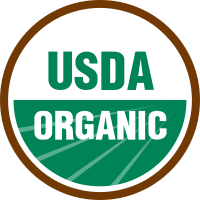 In the U.S., certification is handled by state, non-profit and private agencies that have been approved by the US Department of Agriculture (USDA). Federal organic legislation defines three levels of organics. Products made entirely with certified organic ingredients and methods can be labeled "100% organic". Products with at least 95% organic ingredients can use the word "organic". Both of these categories may also display the USDA organic seal. A third category, containing a minimum of 70% organic ingredients, can be labeled "made with organic ingredients". In addition, products may also display the logo of the certification body that approved them.
In the U.S., certification is handled by state, non-profit and private agencies that have been approved by the US Department of Agriculture (USDA). Federal organic legislation defines three levels of organics. Products made entirely with certified organic ingredients and methods can be labeled "100% organic". Products with at least 95% organic ingredients can use the word "organic". Both of these categories may also display the USDA organic seal. A third category, containing a minimum of 70% organic ingredients, can be labeled "made with organic ingredients". In addition, products may also display the logo of the certification body that approved them.
“Natural” or “All Natural” does not mean organic. There is no standard definition for this term except with meat and poultry products. (USDA defines “natural” as not containing any artificial flavoring, colors, chemical preservatives, or synthetic ingredients). The claim is not verified. The producer or manufacturer alone decides whether to use it.
The USDA carries out routine inspections of farms that produce USDA Organic labeled foods. Of the 30 third party inspectors 15 of them have been placed under probation after an audit. On April 20, 2010, the Department of Agriculture said that it would begin enforcing rules requiring the spot testing of organically grown foods for traces of pesticides, after an auditor exposed major gaps in federal oversight of the organic food industry.
Nutritional Value and Taste:
In April 2009, results from a 5-year integrated study funded by the European Commission confirmed that "the quality of crops and livestock products from organic and conventional farming systems differs considerably." Specifically, results "showed that organic food production methods resulted, in some cases: (a) higher levels of nutritionally desirable compounds (e.g., vitamins, antioxidants and polyunsaturated fatty acids such as omega-3 and CLA); (b) lower levels of nutritionally undesirable compounds such as heavy metals, mycotoxins, pesticide residues and glycoalkaloids in a range of crops and/or milk; (c) a lower risk of fecal Salmonella shedding in pigs", but also showed no significant difference between traditionally grown foods on other studies. The study also concludes that "further and more detailed studies are required to provide proof for positive health impacts of organic diets on human and animal health."
According to the UK's Food Standards Agency (FSA), "Consumers may choose to buy organic fruit, vegetables and meat because they believe them to be more nutritious than other food. However, the balance of current scientific evidence does not support this view." A 12-month systematic review commissioned by the FSA in 2009 and conducted at the London School of Hygiene & Tropical Medicine based on 50 years' worth of collected evidence concluded that "there is no good evidence that consumption of organic food is beneficial to health in relation to nutrient content."
Other studies have found no proof that organic food offers greater nutritional values, more consumer safety or any distinguishable difference in taste. Regarding taste, a 2001 study concluded that organic apples were sweeter by blind taste test. Firmness of the apples was also rated higher than those grown conventionally.
Current studies have not found differences in the amounts of natural biotoxins between organic and conventional foods.
Organic Farming
Organic farming is the form of agriculture that relies on techniques such as crop rotation, green manure, compost and biological pest control to maintain soil productivity and control pests on a farm. Organic farming excludes or strictly limits the use of manufactured fertilizers, pesticides (which include herbicides, insecticides and fungicides), plant growth regulators such as hormones, livestock antibiotics, food additives, and genetically modified organisms (GMOs).
According to the International Federation of Organic Agriculture Movements (IFOAM), an international umbrella organization for organic farming organizations established in 1972,
"Organic agriculture is a production system that sustains the health of soils, ecosystems and people. It relies on ecological processes, biodiversity and cycles adapted to local conditions, rather than the use of inputs with adverse effects. Organic agriculture combines tradition, innovation and science to benefit the shared environment and promote fair relationships and a good quality of life for all involved."
A key characteristic of organic farming is the rejection of genetically engineered plants and animals. However, some organic farmers question the rationale behind the ban on the use of genetically engineered seed because they see it a biological technology consistent with organic principles.
Although GMOs are excluded from organic farming, there is concern that the pollen from genetically modified crops is increasingly penetrating organic and heirloom seed stocks, making it difficult, if not impossible, to keep these genomes from entering the organic food supply.
Some entities such as the European Union subsidize organic farming, in large part because these countries want to account for the externalities of reduced water use, reduced water contamination, reduced soil erosion, reduced carbon emissions, increased biodiversity, and assorted other benefits that result from organic farming.
Traditional organic farming is labor and knowledge-intensive whereas conventional farming is capital-intensive, requiring more energy and manufactured inputs.
Environmental Impact:
Several surveys and studies have attempted to examine and compare conventional and organic systems of farming. The general consensus across these surveys is that organic farming is less damaging for the following reasons:
- Organic farms do not consume or release synthetic pesticides into the environment—some of which have the potential to harm soil, water and local terrestrial and aquatic wildlife.
-
Organic farms do not consume or release synthetic pesticides into the environment—some of which have the potential to harm soil, water and local terrestrial and aquatic wildlife.
-
Organic farms are better than conventional farms at sustaining diverse ecosystems, i.e., populations of plants and insects, as well as animals.
-
When calculated either per unit area or per unit of yield, organic farms use less energy and produce less waste, e.g., waste such as packaging materials for chemicals.
The environmental impact of pesticides as well as the impact to the health of farm workers are reasons given for purchasing organic food. However, critics of organic farming methods believe that the increased land needed to farm organic food could potentially destroy the rainforests and wipe out many ecosystems.
Organic farming reduces pollutants in groundwater and creates richer soil that aids plant growth while reducing erosion, according to the Organic Trade Association. It also decreases pesticides that can end up in your drinking glass; in some cities, pesticides in tap water have been measured at unsafe levels for weeks at a time, according to an analysis performed by the Environmental Working Group (EWG). (To find out about the safety of your tap water, visit the EWG website at: ewg.org/tapwater/yourwater.)
Nearly all non-crop, naturally occurring species observed in comparative farm land practice studies show a preference for organic farming both by abundance and diversity. An average of 30% more species inhabit organic farms. Birds, butterflies, soil microbes, beetles, earthworms, spiders, vegetation, and mammals are particularly affected. Lack of herbicides and pesticides improve biodiversity fitness and population density. Many weed species attract beneficial insects that improve soil qualities and forage on weed pests. Soil-bound organisms often benefit because of increased bacteria populations due to natural fertilizer such as manure, while experiencing reduced intake of herbicides and pesticides. Increased biodiversity, especially from beneficial soil microbes and mycorrhizae have been proposed as an explanation for the high yields experienced by some organic plots, especially in light of the differences seen in a 21-year comparison of organic and control fields
Organic agriculture can decrease fossil fuel emissions and, like any well managed agricultural system, sequesters carbon in the soil. The elimination of synthetic nitrogen in organic systems decreases fossil fuel consumption by 33% and carbon sequestration takes CO2 (carbon dioxide) out of the atmosphere by putting it in the soil in the form of organic matter which is often lost in conventionally managed soils.
Productivity:
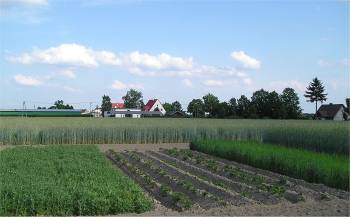 A 2007 study compiling research from 293 different comparisons into a single study to assess the overall efficiency of the two agricultural systems has concluded that
A 2007 study compiling research from 293 different comparisons into a single study to assess the overall efficiency of the two agricultural systems has concluded that
...organic methods could produce enough food on a global per capita basis to sustain the current human population, and potentially an even larger population, without increasing the agricultural land base. (from the abstract)
The researchers also found that while in developed countries, organic systems on average produce 92% of the yield produced by conventional agriculture, organic systems produce 80% more than conventional farms in developing countries, because the materials needed for organic farming are more accessible than synthetic farming materials to farmers in some poor countries. On the other hand, communities that lack sufficient manure to replenish soils would struggle with organic farming, and the soil would degrade rapidly.
Organic farms withstand severe weather conditions better than conventional farms, sometimes yielding 70-90% more than conventional farms during droughts. Organic farms are more profitable in the drier states of the United States, likely due to their superior drought performance.
Organic farms survive hurricane damage much better, retaining 20 to 40% more topsoil and smaller economic losses at highly significant levels than their neighbors.
Contrary to widespread belief, organic farming can build up soil organic matter better than conventional no-till farming, which suggests long-term yield benefits from organic farming.
Consumer Safety:
-
Claims of improved safety of organic food has largely focused on pesticide residues. While studies have shown organically grown fruits and vegetables have significantly lower pesticide residue levels, the significance of this finding on actual health risk reduction is debatable as both conventional foods and organic foods generally have pesticide levels well below government established guidelines for what is considered safe. This view has been echoed by the U.S. Department of Agriculture and the UK Food Standards Agency.
-
Claims of increased risk related to pesticide residue and rates of infertility or lower sperm counts have not been supported by the evidence in the medical literature.
-
Some focus has been placed on the amount of nitrogen content in certain vegetables, especially green leafy vegetables and tubers when grown organically as compared to conventionally. While these vegetables, when grown organically, have been found to have lower nitrogen content, there is no consensus as to whether consumption of lower levels of nitrogen translates to improved health risk.
-
When evaluating environmental toxins such as heavy metals, the USDA noted that organically raised chicken may have lower arsenic levels, while a literature review found no significant evidence that levels of arsenic, cadmium or other heavy metals differed significantly between organic and conventional food products.
-
In looking at possible increased risk to safety from organic food consumption, reviews have found that although there are theoretical increased risk from microbiological contamination due to increased manure use as fertilizer from organisms like E. coli O157:H7 during organic produce production, there does not exist sufficient evidence of actual incidence of outbreaks that can be clearly tied to organic food production to draw any firm conclusions.
-
Other possible sources of increased safety risk from organic food consumption like use of biological pesticides or the theoretical risk from mycotoxins from fungi grown on products due to the lack of effective organic compliant fungicides have likewise not been confirmed by rigorous studies in the scientific literature.
Conventional Industrial Farming
Industrial farming is a form of intensive farming that refers to the industrialized production of livestock, poultry, fish, and crops. Intensive farming or intensive agriculture is an agricultural production system characterized by the high inputs of capital, labor, or heavy usage of technologies such as pesticides and chemical fertilizers relative to land area.
This is in contrast to many sorts of sustainable agriculture such as organic farming or extensive agriculture, which involve a relatively low input of labor, relative to the area of land farmed, and which focus on maintaining long-term ecological health of farmland, so that it can be farmed indefinitely.
Most of the meat, dairy, eggs, fruits, and vegetables available in supermarkets are produced using these methods of industrial agriculture. According to the Worldwatch Institute, 74% of the world's poultry, 43% of beef, and 68% of eggs are produced this way.
Methods:
The methods of industrial agriculture are technoscientific, economic, and political. They include innovation in agricultural machinery and farming methods, genetic engineering (GE), techniques for achieving economies of scale in production, the creation of new markets for consumption, the application of patent protection to genetic information, and global trade. These methods are widespread in developed nations and increasingly prevalent worldwide.
As John Ikerd, Professor Emeritus of Agricultural Economics at the University of Missouri so eloquently puts it in his article The Industrialization of Agriculture: Why We Should Stop Promoting It:
"The industrialization of agriculture allowed us through specialization, mechanization, simplification, and routinization to bend nature to serve our needs. We gradually harnessed the vagaries of biological processes and transformed farms into factories without roofs. Our fields and feed lots became biological assembly lines with inputs coming in one side and commodities going out the other. We achieved the economies of large-scale, specialized production as we applied the principles, strategies, and technologies of industrialization to farming."
Monoculture is one such example. Monoculture the agricultural practice of producing or growing one single crop over a wide area. It is widely used in modern industrial agriculture and its implementation has allowed for large harvests from minimal labor. These cultivars have uniform growing requirements and habits resulting in greater yields on less land because planting, maintenance (including pest control) and harvesting can be standardized. This standardization results in less waste and loss from inefficient harvesting and planting. However, monocultures can lead to the quicker spread of diseases, where a uniform crop is susceptible to a pathogen.
"Crop monoculture" is the practice of growing the same crop year after year. The term "monoculture" is frequently borrowed for other uses, such as raising one species of livestock in a factory farm.
The problem is now is that in its mad rush to create more and cheaper food at higher and higher profits, the industrial paradigm has become increasingly unsustainable.
Genetically Modified Foods Controversy:
The genetically modified foods controversy is a dispute over the relative advantages and disadvantages of genetically modified (GM) food crops and other uses of genetically-modified organisms (GMOs) in food production. The dispute involves biotechnology companies, governmental regulators, non-governmental organizations and scientists. The dispute is most intense in Japan and Europe, where public concern about GM food is higher than in other parts of the world such as the United States. In the United States GM crops are more widely grown and the introduction of these products has been less controversial.
The genetic engineering of agricultural crops can increase the growth rates and resistance to different diseases caused by pathogens and parasites. This is beneficial as it can greatly increase the production of food sources with the usage of fewer resources that would be required to host the world's growing populations. These modified crops would also reduce the usage of chemicals, such as fertilizers and pesticides, and therefore decrease the severity and frequency of the damages produced by these chemical pollution.
However, valid ethical and safety concerns have been raised around the use of genetically modified food. The key areas of concern related to genetically engineered food are food safety, in particular whether toxic or allergic reactions could occur; the effect on natural ecosystems and its the impact on biodiversity; gene flow into non-genetically engineered crops, moral/religious issues; corporate control of the food supply; and intellectual property rights and the level of labeling needed on genetically modified products.
Challenges and Issues:
The challenges and issues of industrial agriculture for global and local society, for the industrial agriculture sector, for the individual industrial agriculture farm, and for animal rights include the costs and benefits of both current practices and proposed changes to those practices.
While the point of industrial agriculture is lower cost products to create greater productivity thus a higher standard of living as measured by available goods and services, industrial methods have side effects both good and bad. Further, industrial agriculture is not some single indivisible thing, but instead is composed of numerous separate elements, each of which can be modified, and in fact is modified in response to market conditions, government regulation, and scientific advances. So the question then becomes for each specific element that goes into an industrial agriculture method or technique or process: What bad side effects are bad enough that the financial gain and good side effects are outweighed? Different interest groups not only reach different conclusions on this, but also recommend differing solutions, which then become factors in changing both market conditions and government regulations.
The major challenges and issues faced by society concerning industrial agriculture include:
Maximizing the benefits:
- Cheap and plentiful food
- Convenience for the consumer
- The contribution to our economy on many levels, from growers to harvesters to processors to sellers
while minimizing the downsides:
- Environmental and social costs
- Damage to fisheries
- Factory farming animal cruelty issues revolve around the limiting of natural behavior in animals due to their indoor confinement at a high stocking density (see battery cage, veal and gestation crate), and invasive procedures such as debeaking and mulesing. Other issues include methods of animal slaughter, especially ritual slaughter.
- Cleanup of surface and groundwater polluted with animal waste
- Increased health risks from pesticides
- Increased ozone pollution and global warming from heavy use of fossil fuels
Industrial agriculture uses huge amounts of water, energy, and industrial chemicals; increasing pollution in the arable land, usable water and atmosphere. Herbicides, insecticides, fertilizers, and animal waste products are accumulating in ground and surface waters.
The Union of Concerned Scientists stated in their article, The Costs and Benefits of Industrial Agriculture: Sustainable Agriculture–A New Vision, "Many of the negative effects of industrial agriculture are remote from fields and farms. Nitrogen compounds from the Midwest, for example, travel down the Mississippi to degrade coastal fisheries in the Gulf of Mexico. But other adverse effects are showing up within agricultural production systems—for example, the rapidly developing resistance among pests is rendering our arsenal of herbicides and insecticides increasingly ineffective."
Crop irrigation accounts for 70% of the world's fresh water use. The agricultural sector of most countries is important both economically and politically, and water subsidies are common. Water conservation advocates have urged removal of all subsidies to force farmers to grow more water-efficient crops and adopt less wasteful irrigation techniques. Optimal water efficiency means minimizing losses due to evaporation, runoff or subsurface drainage.
Sustainable Agriculture
Sustainable agriculture is the practice of farming using principles of ecology, the study of relationships between organisms and their environment. It has been defined as "an integrated system of plant and animal production practices having a site-specific application that will last over the long term:
- Satisfy human food and fiber needs
- Make the most efficient use of non-renewable resources and on-farm resources and integrate, where appropriate, natural biological cycles and controls
- Sustain the economic viability of farm operations
- Enhance the quality of life for farmers and society as a whole."
As consumer and retail demand for sustainable products has risen, organizations such as Food Alliance and Protected Harvest have started to provide measurement standards and certification programs for what constitutes a sustainably grown crop. There is a federal agency, USDA-Natural Resources Conservation Service that specializes in providing technical and financial assistance for those interested in pursuing natural resource conservation and production agriculture as compatible goals.
Practices that can cause long-term damage to soil include excessive tillage (leading to erosion) and irrigation without adequate drainage (leading to salinization).
In some areas, sufficient rainfall is available for crop growth, but many other areas require irrigation. For irrigation systems to be sustainable they require proper management (to avoid salinization) and must not use more water from their source than is naturally replenished, otherwise the water source becomes, in effect, a non-renewable resource.
Several steps should be taken to develop drought-resistant farming systems even in "normal" years, including both policy and management actions:
- improving water conservation and storage measures,
- providing incentives for selection of drought-tolerant crop species,
- using reduced-volume irrigation systems,
- managing crops to reduce water loss, or
- not planting at all.
Sustainable agriculture depends on replenishing the soil while minimizing the use of non-renewable resources, such as natural gas (used in converting atmospheric nitrogen into synthetic fertilizer), or mineral ores (e.g., phosphate). Possible sources of nitrogen that would, in principle, be available indefinitely, include:
- recycling crop waste and livestock or treated human manure
- growing legume crops and forages such as peanuts or alfalfa that form symbioses with nitrogen-fixing bacteria called rhizobia
- industrial production of nitrogen by the Haber Process uses hydrogen, which is currently derived from natural gas, (but this hydrogen could instead be made by electrolysis of water using electricity (perhaps from solar cells or windmills)) or
- genetically engineering (non-legume) crops to form nitrogen-fixing symbioses or fix nitrogen without microbial symbionts.
More realistic, and often overlooked, options include long-term crop rotations, returning to natural cycles that annually flood cultivated lands (returning lost nutrients indefinitely) such as the Flooding of the Nile, the long-term use of biochar, and use of crop and livestock landraces that are adapted to less than ideal conditions such as pests, drought, or lack of nutrients.
Biochar is charcoal created by pyrolysis of biomass, and differs from charcoal only in the sense that its primary use is not for fuel, but for biosequestration or atmospheric carbon capture and storage. Charcoal is a stable solid rich in carbon content, and thus, can be used to lock carbon in the soil for hundreds to thousands of years, like coal. Biochar is of increasing interest because of concerns about climate change caused by emissions of carbon dioxide (CO2) and other greenhouse gases (GHG).
Soil erosion is fast becoming one of the worlds greatest problems. Without efforts to improve soil management practices, the availability of arable soil will become increasingly problematic. Some soil management techniques include:
- No-till farming
- Keyline design
- Growing wind breaks to hold the soil
- Incorporating organic matter back into fields
- Stop using chemical fertilizers (which contain salt)
- Protecting soil from water runoff
Agroforestry:
Agroforestry is an integrated approach of using the interactive benefits from combining trees and shrubs with crops and/or livestock. It combines agricultural and forestry technologies to create more diverse, productive, profitable, healthy and sustainable land-use systems. Agroforestry systems can be advantageous over conventional agricultural and forest production methods through increased productivity, economic benefits, social outcomes and the ecological goods and services provided.
Biodiversity in agroforestry systems is typically higher than in conventional agricultural systems. Agroforestry incorporates at least several plant species into a given land area and creates a more complex habitat that can support a wider variety of birds, insects, and other animals. Agroforestry also has the potential to help reduce climate change since trees take up and store carbon at a faster rate than crops.
Agroforestry practices may also be employed to realize a number of other associated Environmental Services, including:
- Carbon sequestration
- Odor, dust, and noise reduction
- Waste water or manure management (e.g. utilizing urban waste water on intensive, short rotation forests for wood fibre production)
- Green space and visual aesthetics.
- Enhancement or maintenance of wildlife habitat.
Intercropping:
Intercropping is the practice of growing two or more crops in close proximity. The most common goal of intercropping is to produce a greater yield on a given piece of land by making use of resources that would otherwise not be utilized by a single crop. Examples of intercropping strategies are planting a deep-rooted crop with a shallow-rooted crop, or planting a tall crop with a shorter crop that requires partial shade.
Intercropping of compatible plants also encourages biodiversity, by providing a habitat for a variety of insects and soil organisms that would not be present in a single crop environment. This biodiversity can in turn help to limit outbreaks of crop pests (Altieri 1994) by increasing the diversity or abundance of natural enemies, such as spiders or parasitic wasps.
Intercropping can also increase total yields per unit of area or reduce inputs to achieve the same, and thus represents (potentially sustainable) agricultural intensification.
Urban Vertical Farming: A Brave New World
Vertical farming, a type of intensive crop production that would grow food on a large scale in urban centers, has been proposed as a way to reduce the negative environmental impact of traditional rural agriculture. Vertical farming is a concept that argues that it is economically and environmentally viable to cultivate plant or animal life within skyscrapers, or on vertically inclined surfaces.
Proponents argue that, by allowing traditional outdoor farms to revert to a natural state and reducing the energy costs needed to transport foods to consumers, vertical farms could significantly alleviate climate change produced by excess atmospheric carbon. Critics have noted that the costs of the additional energy needed for artificial lighting, heating and other vertical farming operations would outweigh the benefit of the building’s close proximity to the areas of consumption.
It is estimated that by the year 2050, close to 80% of the world’s population will live in urban areas and the total population of the world will increase by 3 billion people. A very large amount of land may be required depending on the change in yield per hectare. Scientists are concerned that this large amount of required farmland will not be available and that severe damage to the earth will be caused by the added farmland. Vertical farms, if designed properly, may eliminate the need to create additional farmland and help create a cleaner environment.
Unlike traditional farming in non-tropical areas, indoor farming can produce crops year-round. All-season farming multiplies the productivity of the farmed surface by a factor of 4 to 6 depending on the crop. With some crops, such as strawberries, the factor may be as high as 30. Furthermore, as the crops would be sold in the same infrastructures in which they are grown, they will not need to be transported between production and sale, resulting in less spoilage, infestation, and energy required than conventional farming encounters. Research has shown that 30% of harvested crops are wasted due to spoilage and infestation, though this number is much lower in developed nations.
 Despommier suggests that, if dwarf versions of certain crops are used (e.g. dwarf wheat developed by NASA, which is smaller in size but richer in nutrients), year-round crops, and "stacker" plant holders are accounted for, a 30-story building with a base of a building block (5 acres) would yield a yearly crop analogous to that of 2,400 acres of traditional farming.
Despommier suggests that, if dwarf versions of certain crops are used (e.g. dwarf wheat developed by NASA, which is smaller in size but richer in nutrients), year-round crops, and "stacker" plant holders are accounted for, a 30-story building with a base of a building block (5 acres) would yield a yearly crop analogous to that of 2,400 acres of traditional farming.
Crops grown in traditional outdoor farming suffer from the often suboptimal, and sometimes extreme, nature of geological and meteorological events such as undesirable temperatures or rainfall amounts, monsoons, hailstorms, tornados, flooding, wildfires, and severe droughts. The protection of crops from weather is increasingly important as global climate change occurs.
Because Vertical Farming provides a controlled environment, the productivity of vertical farms would be mostly independent of weather and protected from extreme weather events. Although the controlled environment of vertical farming negates most of these factors, earthquakes and tornados still pose threats to the proposed infrastructure, although this again depends on the location of the vertical farms.
Because vertical farming lets crops be grown closer to consumers, it would substantially reduce the amount of fossil fuels currently used to transport and refrigerate farm produce. Producing food indoors reduces or eliminates conventional plowing, planting, and harvesting by farm machinery, also powered by fossil fuels. Burning less fossil fuel would reduce air pollution and the carbon dioxide emissions that cause climate change, as well as create healthier environments for humans and animals alike.
 The controlled growing environment reduces the need for pesticides, namely herbicides and fungicides. Advocates claim that producing organic crops in vertical farms is practical and the most likely production and marketing strategy.
The controlled growing environment reduces the need for pesticides, namely herbicides and fungicides. Advocates claim that producing organic crops in vertical farms is practical and the most likely production and marketing strategy.
Opponents question the potential profitability of vertical farming. The extra cost of lighting, heating, and powering the vertical farm may negate any of the cost benefits received by the decrease in transportation expenses. The economic and environmental benefits of vertical farming rest partly on the concept of minimizing food miles, the distance that food travels from farm to consumer. However, a recent analysis suggests that transportation is only a minor contributor to the economic and environmental costs of supplying food to urban populations.
However, some of the extra cost associated with lighting, heating, and powering vertical farms can be offset by using green energy, such as solar energy. Also, vertical farms could exploit methane digesters to generate a small portion of its own electrical needs. Methane digesters could be built on site to transform the organic waste generated at the farm into biogas which is generally composed of 65% methane along with other gasses. This biogas could then be burned to generate electricity for the greenhouse.
Please buy humanely-raised, cruelty-free meat, seafood and poultry, and support more substainable agriculture.
CHOW Tips:
 |
BEER: 3 ways to chill beer, how to pair beer with food, how to identify off flavors in beer, and more. |
 |
WINE: The best cheap wines, how to properly chill wine, wine tasting, wine paIring, and more. |
 |
SPIRITS: How to taste fine spirits, when to blow on your liquor, how to make the perfect martini and more. |
 |
MEAT & POULTRY: How to choose fresh meat, how to grill, how to make the perfect hamburger, and more. |
 |
SEAFOOD: 22 back-of-the-house secrets from chefs, such as how to buy fresh fish, and how to smoke or grill seafood. |
 |
CHEESE: How to buy cheese, how to cut and serve cheese, whether or not to freeze cheese, and more. |
 |
COFFEE: Banish bitter coffee from your repertoire. CHOW Tips will help brew a delicious cup every time. |
Contact Us | Shop | Sitemap | Join Our Team | Investors | Advertise | Web Design Services
Community | Foodies' Choice | Meetup Groups | Chat | Blogs | Forums | Submit Your Site | Resources

